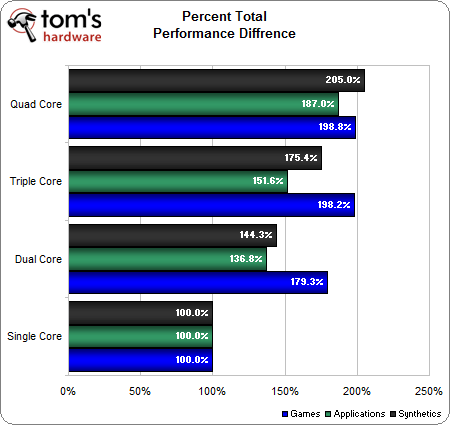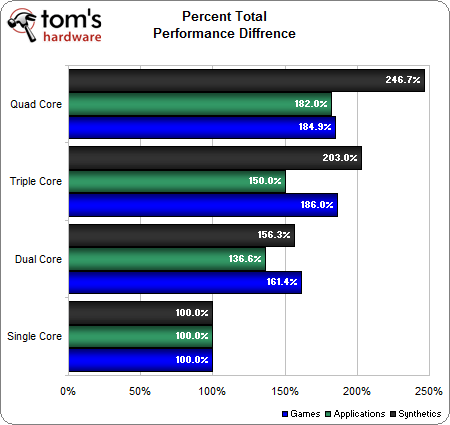Part 2: How Many CPU Cores Do You Need?
Performance Analysis
Let's begin by looking at the big picture. Here is a graph showing the average relative performance when using the Phenom II with one, two, three, and four CPU cores enabled:
The blue bar represents game performance, the green bar represents application performance, and the dark bar represents synthetic performance.
First off, let's look at the gaming results. We get the impression that, compared to a single-core CPU, there is a huge benefit to using at least a dual-core CPU when gaming. After that, increasing the number of CPU cores provides a small increase in performance, with triple-core CPUs providing the same performance as a quad-core processor.
When we scrutinize application performance, we see a more linear progression, suggesting that multithreaded apps are better-suited to take advantage of multiple CPU cores. Do keep in mind that certain applications showed no increase in performance, as they aren't threaded. So, the programs you run will directly influence the actual performance increase.
The synthetic results appear as slightly exaggerated application results, which bodes well for the argument that synthetic benchmarks are a useful tool in looking forward--here, measuring multithreaded performance.
It is interesting to note that once four CPU cores are used, both application and game performance run about twice as fast as they do on a single-core CPU.
Now that we've examined this, let's look at the average performance graph from the previous article, where we used the Core 2 Quad Q6600 as our test case:
Get Tom's Hardware's best news and in-depth reviews, straight to your inbox.
In general, the results paint a similar picture, even though some of the details are a little different. The most notable change from the Phenom II results is the synthetic results, which seem far too optimistic in the Core 2 Quad tests. Application performance is similar on the whole, showing comparable increases with each CPU core that is utilized. Even the game results are fairly close. Therefore, we can say with some certainty that the split cache on the Core 2 Quad Q6600 didn't affect the results enough to invalidate them in the previous review.
The other notable tidbit we learned wasn't too much of a surprise: as the concurrent application benchmark demonstrated, even though triple- and quad-core CPUs might show nearly-identical results in a given benchmark, these results can drastically change when more than one application is run at the same time. If you have a quad-core CPU, you're more likely to be able to run an application in the background without as much of a performance penalty. Conversely, folks with fewer CPU cores at their disposal may want to pay attention to the apps running in the background and terminate them if they're participating in a CPU-intensive task, like a game.
Current page: Performance Analysis
Prev Page Simulated Dual-Core Versus Actual Dual-Core Comparison Next Page ConclusionDon Woligroski was a former senior hardware editor for Tom's Hardware. He has covered a wide range of PC hardware topics, including CPUs, GPUs, system building, and emerging technologies.
-
erdinger Very intresting article,now I'm even happyery I bought a Phenom II 720 for my gaming rig!Reply -
icepick314 "In any case, there are two lessons to be learned here: first, try to avoid a virus scan during your gaming sessions."Reply
what kind of PC gamer does virus scanning while running a game? -
KyleSTL Why no power consumption testing? I was a little curious what disabling cores in the OS would do to power consumption under load. A little let down, but otherwise good article. It's good to see a scaling article at least yearly since people refer to the dual/quad debate so often and often the tests that were run within article that are referenced are out of date and irrelavent.Reply -
Onus Good article, and very interesting.Reply
Now I really hope I can unlock the 4th core when my 720BE arrives (hopefully later this afternoon), but I won't sweat it.
Did you happen to test if it made a difference what scan priority was set in AVG? I'd really like to see those numbers.
-
So, how did you manage to get an Nvidia-based graphics card (Gigabyte GV-N250ZL-1GI 1 GB DDR3 PCIe) up and running with the ATI Catalyst 9.6 drivers?! ;-)Reply
Besides that bit of confusion, thanks for the benchmarks! -
1word very happy with my 720 BE. I constantly check with the activity on the cores, and many many apps use all three cores, or multi- tasking uses all the 3 cores. some activities like defrag uses only 2 cores. image editing software, and general applications like browsers, office apps use all three cores, especially when multi tasking.Reply
i'm very happy with the AMD 720BE. -
jcknouse KyleSTLWhy no power consumption testing? I was a little curious what disabling cores in the OS would do to power consumption under load. A little let down, but otherwise good article. It's good to see a scaling article at least yearly since people refer to the dual/quad debate so often and often the tests that were run within article that are referenced are out of date and irrelavent.Reply
I liked the article well, but I was too finding myself asking "What was more power efficient? the PII x2 550 BE or the PII x2 955 BE?
Would love to know, even if it was just that you guys just happened to glance at a P3 Kill-a-watt or some other meter you had inline during testing or something.
Thanks for great work, guys :) -
erichlund It's true that an application like iTunes does not benefit from multiple cores, when run without any other apps. However, it also doesn't compete for more than one core when multiple apps are running, so single threaded apps also benefit from multiple cores when users are multi-tasking.Reply
What one really needs to know with iTunes and it's competing applications is: Which one competes most efficiently in a multi-processing environment? In other words, which uses the least resources while performing essential tasks, leaving the most resources for the other tasks being performed? To say it in perhaps the clearest way, what applications play well with other types while multi-tasking, and which hog resources, making it more difficult to multi-task?
That's not really the point of this test, but it may lead to some interesting future evaluations. -
Onus ^Yes, that's why it would be interesting to see if (and how much) the impact varied if AVG was set to slow, normal, or fast for its scan priority.Reply -
paranoidmage You shouldn't test the games at 1024x786 at low details. These benchmarks are supposed to simulate actual usage. No one will actually run games at that resolution and detail unless their computer is a dinosaur. If you want to remove bottlenecks, use a better GPU like a 4890.Reply
How do I know if multiple core will actually help me? I run games at 1920x1200 with med-high details.

